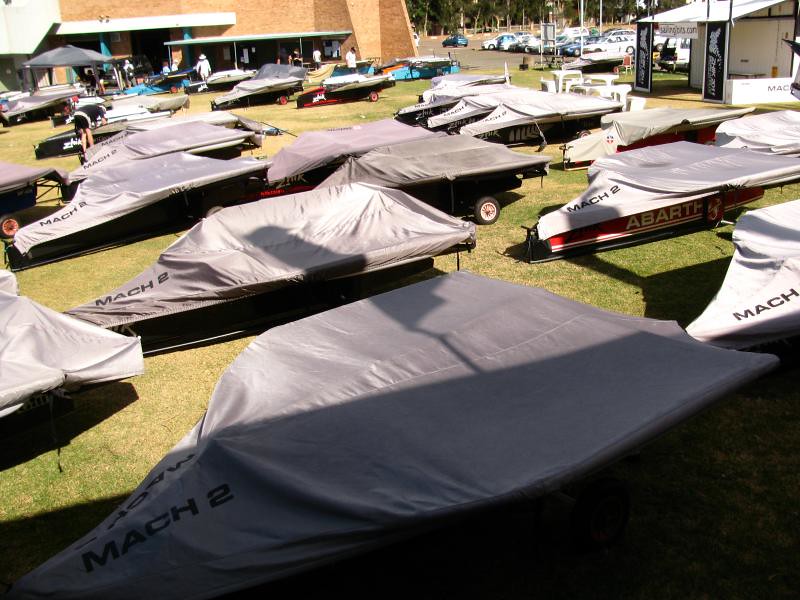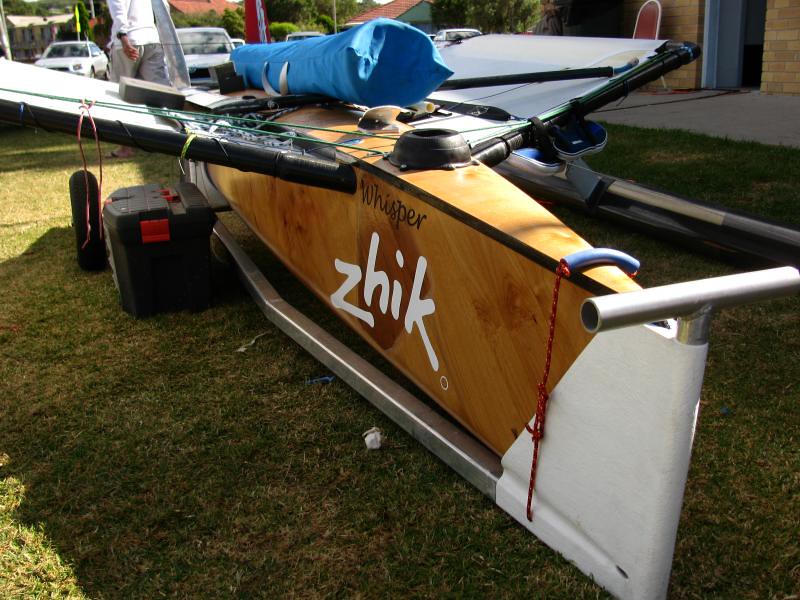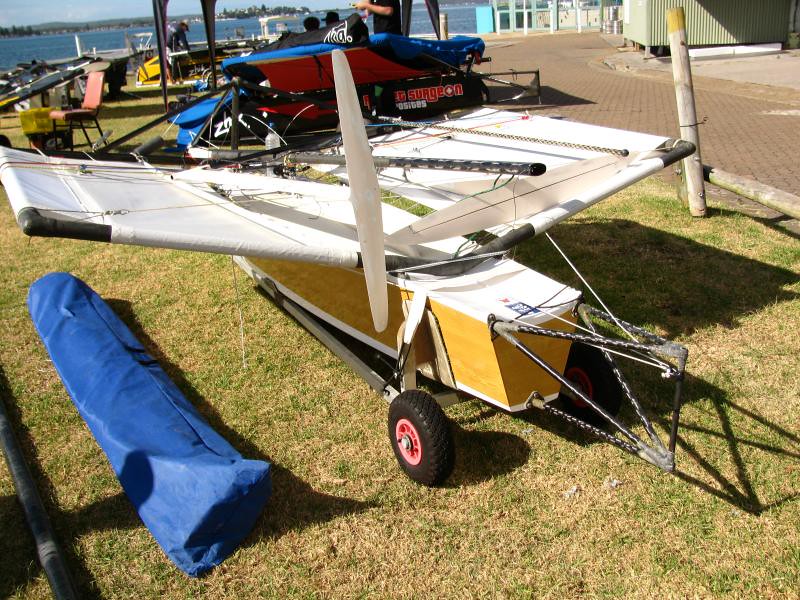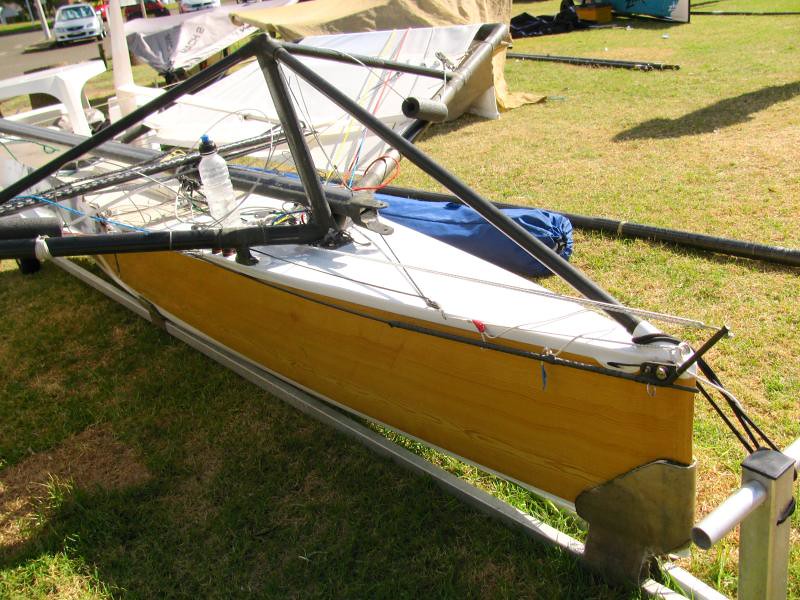 Thanks: 0
Thanks: 0
 Needs Pictures: 0
Needs Pictures: 0
 Picture(s) thanks: 0
Picture(s) thanks: 0
Results 496 to 510 of 655
-
3rd January 2011, 11:31 AM #496
 Senior Member
Senior Member











- Join Date
- Mar 2010
- Location
- Queenstown New Zealand
- Posts
- 382

Hi Bruce, great information!
Interesting that you are moving the sail so far back when beating when you have a vang as well. This seems to be what the Key Haven Scows are doing, where's that picture? I have some memory of one of the top PDR sailors finding that the balance lugsail pointed a lot higher if set with very little in front of the mast and a vang. Defeats some of the self vanging purpose and simplicity of the balance lug, but for me the main plusses I am after are fast and reliable ability to drop the sail and reef it, and the balance being maintained as I reef to a much smaller sail area.
I have three quite closely spaced (600mm) reefs on my sail, so I think I'll try my idea with the vertical hole in front of the tack, I can always leave the lines off if I'm sailing close to home, or just put the line to the second reef in place - It's presumably the one that will most likely be put in under some pressure to do so - hopefully by the time a third reef is required I'll already be somewhere safe!
Ian
Found the picture I was looking for:
-
3rd January 2011 11:31 AM # ADSGoogle Adsense Advertisement
- Join Date
- Always
- Location
- Advertising world
- Posts
- Many
-
9th January 2011, 08:01 AM #497

Hi Ian
Yes, I feel that moving the sail back does in fact help pointing ability. As MIK said to me yesterday, this could be that I'm more familiar with the boat now, but my gut feeling is that I have improved upwind performance now. I am outpointing Lasers so I have to be happy with that. My only problem is when the breeze is over 10 knots (and therefore gusting approx 15kts), then the 105 sq ft is a bit much for me alone to keep the boat powered up and sailed flat when going upwind. On Belmont Bay yesterday while watching the first elimination Moth races, we had 8-10kts, gusting 15 and MIK and I were both hiking in the puffs
What a great day's sailing it was, and MIK is such a knowledgeable person, so I learned so much.
-
9th January 2011, 08:09 AM #498

Some pics from yesterday. MIK took a whole lot more than I did, including some very detailed close-ups of the engineering aspects. He was in his element with that stuff! Thanks for great day's sailing MIK!!!
Nice hat MIK!
Attachment 158082
Some of the MOTH fleet at Belmont 16 Footer sailing Club yesterday.
Attachment 158083
Woodie. (Not really, just well disguised carbon)
Attachment 158084
Attachment 158085
Attachment 158086
How to drain water from a Moth
Attachment 158087
-
9th January 2011, 09:20 AM #499
 Senior Member
Senior Member











- Join Date
- Mar 2010
- Location
- Queenstown New Zealand
- Posts
- 382

Good to hear you caught up with Mik and got out on the water.
Interesting /great you have got your boat pointing higher than a Laser.
John Goodman reported that in the Texas 200 he could beat a Core Sound or Sea Pearl a little off the wind, but got pasted by them tacking up a channel, so good to see a bit or rig development can overcome any poorer upwind ability. (Does the Yawl rig cost you a lot upwind, I'd be curious to hear John's opinion as he's sailed with and without the mizzen)
Have you thought of/tried taking a wooden or aluminium ladder out and using it as a leaning plank when you're racing solo yet!?
On a completely different topic, do you or Mik have a picture/description/link to how the altitude control works on these Moths - understand there is a wand that sticks down near the bow, and that is somehow connected to the variable pitch lifting foils, but how exactly does this work? Haven't found anything detailed on the web yet.
Thanks, Ian
-
9th January 2011, 03:24 PM #500

Yes, I still have the leaning plank on a list of stuff to try with the GIS.
As you say, altitude in the Moths is controlled by that wand at the bow which skips across the surface of the water. There are solid carbon rods which transmit the wands position back to the top of the foil, which in turn connects to another rod that runs down the centre of the foil and which in turn sets the aileron position. I was surprised that there was no mechanical advantage at all to the ailerons, ie. no hydraulics or fancy levers that I could see.
The pitch is controlled by a simple twisting tiller extension, but there are no ailerons on the rudder foil. The rudder foil justs swings back and forth. (I think!)
Amazing machines. As sail boats go, I think they are "machines" and the learning curve is quite a big one. Most of the sailors can gybe well without dropping the hull into the water, but it's only the top ones who can make tacks through the wind without dropping the hull into the water. We saw lots of instances where dropping the boat off the foils costs 200m in distance. It is apparent that in this class, racing tactics is secondary to boat control.
Interestingly also, the wings are not yet competitive with the sails.
-
9th January 2011, 07:38 PM #501

MIK at the helm of Hakuna Matata (Shesha) on Grahamstown Lake today. The breeze started at around 12kts and later filled in to a very nice 25kts when we went 2-up.
I later discovered that I had made life very difficult for Michael because I'd rigged the ratchet block on the transom the wrong way. Sorry MIK!
[ame=http://www.youtube.com/watch?v=QE25DQ410lQ]YouTube - Goat Island Skiff (GIS) - Grahamstown Lake NSW Australia 9 January 2011[/ame]
That's a video camera strapped to the top of the mast. However we had the angle wrong, and instead of cool bird's eye video of Michael from above, we got some great video of........ water. Oh well, will try next time
Oh well, will try next time
[ame="http://www.youtube.com/watch?v=8MJAHvIuDt0"]YouTube - Goat Island Skiff (GIS) - Mast head view 1[/ame]
Attachment 158203
Guess who, taken from the mast-head
Attachment 158223
More pics here: Picasa Web Albums - Bruce Taylor - Goat Island S...
-
10th January 2011, 10:37 AM #502

Howdy,
I was invited to watch the Moth World Titles at Lake Macquarie from a Goat Island Skiff with its builder Bruce (Woodeneye on this forum) - had my non waterproof camera handy and a few snap lock plastic bags (really just for spray put a folded kitchen towel inside to pick up any condensation or little leaks - but not recommended unless the camera is replaceable).
Anyway looking at the boats before the first race, I was surprised to find two boats with wood looking hulls. In a sense it doesn't make much of a difference for wood technology because so much of the boats are carbon to keep the weight down around 50lbs for the whole shebang.

But one cold moulded hull.

I think many will be interested in the eyesocket type mast mount - the Amateur Yacht Research Society and others have talked about decoupling the rig from the hull for yearsso you can get lift to help pull the boat out of the water. However, racing is always the test - if you see the idea spreading, then it works. No other boats had this system. But it is interesting how complex things can be achieved with composites.

Then there was another boat on the other side of the lot ...

We looked closely - the grain wasn't quite right and a peeled veneer like this would have the strength in all the wrong direction ...

We sailed past him in the Goat Island Skiff when we took pics on the water before one of the starts and we found out that it was indeed a carbon hull with a faux timber paintjob.
Obviously some people have an emotional attachment to wood.
In general the Goat had a similar or better upwind performance to the Moths when they were powered up but not foiling, but once on their foils they zipped away. The noise they make is pretty interesting - just a hiss from turbulence at the water surface.
The good sailors sail with a very different style - a real nose down attitude with lots of windward heel upwind. They can gybe and often tack foilborne. The less experienced or those with bad setup fell off the foils all the time - requiring 30 secs and for less experienced a couple of minutes to get up again.
Capsizes were surprisingly uncommon. Fleet of around 70 and we saw probably 15 capsizes - mostly tail enders. You need a boat that can handle the speed when it falls off the foils.
Wind at times was down to about 5 or 6 knots, but the better boats were foiling throughtut.
A lot of sailing pics here - Moth Worlds 2011 from a Goat Island skiff - lake Macquarie - a set on Flickr
There are nice rigging details of using carbon unidirectional tow and epoxy to "lash" simple fittings like D Rings into place for chainplate attachments, vangs or hounds
Now if my boats had more rigging, that would be a nice approach.
Gradually putting up the videos - they are big files and sometimes crash.
A few of the moths are trying out wing masts.
Hi Jim,
Most of the Moths have sailboard type rigs with camber inducers and a small sock over the mast. Sails are cut quite like a sailboard sail with large luff round that bends the mast through very high downhaul tension. As with most sails if you tighten the luff the leach slackens - so both sailboards and most of the moths seem to have a very soft upper leach. The mast diameter is around 40mm so the rig is quite light.
Some are playing with a wing mast with a carbon D spar about 100mm (4") and then a light tubular structure to take the wing part out to about 550mm/22" (I am guessing these) This is covered in mylar with a single panel of sail behind.
I only saw them sailing, didn't get close. We kept our eye on the front runners in each of the three races and didn't see the wings up there, though you would have to look through the results to be sure.
My gut feeling is that having a wing doesn't quite make sense. With a C-class cat if you have a wing and get a gust you can sail very high, maybe gaining 10 or 15 degrees of pointing angle. You can't do this effectively on a regular soft sailed boat because the sails flap and cause drag. The wing doesn't do this.
However, with a foiling boat you get a gust and you don't point high, you drop off a few degrees and the boat will go a LOT faster. So I think the wing will be working against the foils. The wing strategically opening up the advantage of pointing very high in a gust, but the foils implying you should bear away.
And then there is the weight problem. These boats are so light with all up sailing weights between 30 and 40 lbs (from one of the sailors) -minimal in every way, so it means a wing mast would have to be very light.
If they can be made to work, then they will become common, if they don't become common it probably means they don't work.
Be interesting to double check the results at the end to see if some of the wing mast boats were improving steadily or had at least one very good race. That's how foiling boats started off too. When they had relatively high strength wind takeoffs the conventional boats (similar but non foiled) would not be the quickest, but would occasionally "street" the fleet if the conditions were just right.
All of those hours of sailing of foiled boats around race courses has meant amazing development where the boats formerly required take off winds around 12 knots, but now can get up in about 7 knots of breeze.
Rather 'mazing.
From the Goat
[ame=http://www.youtube.com/watch?v=9JosdNe8-Js]YouTube - Hydrofoilng moth class sailing championships 2011[/ame]
Best wishes
Michael Storer
-
10th January 2011, 09:09 PM #503

There folks, it's official. Goat Island Skiff sails past foiling Moth! Hehe, well our paths did cross, momentarily

A great summary Mick, and what a fantastic day it was checking out what makes these amazing craft tick. As you all know, Mick is such a fountain of knowledge, so it was indeed a privilege to take in his comments while browsing amongst the Moths. We struck up some great conversations with some of the Mothies and got an insight into what drives them. Sailing a foiling Moth is clearly quite a learning curve. However, don't for one minute think that it's a young man's game, as we were told there are guys around 60 sailing them quite competitively.
However, we saw that sailing a Moth is a somewhat wet sport, akin to surfing in a way. Mothies go swimming an awful lot. They go swimming to launch. No retractable centre boards or rudders means they have to carry the thing into deep water. Same thing coming back in....they dump it over on its side and swim it to the shore. And this is after what is, for most skippers, a few dumpings around the racecourse. From what we saw, you are going to need to be pretty fit to sail a Moth competitively.
Sailing a moth around for fun is one thing. Likely you will just be reaching up and down, throwing in a few simple but impressive looking gybes while staying up on the foils. Tacking is quite another story, with most guys unable to keep them on the foils. That was the big difference between the top guys and the rear enders. Anyway, what is evident is that fanging around in a Moth is relatively easy compared with getting the thing around a course. These things can't sail on a run, so after lots of cycles of tack, dump, pump, pump, get foiling, foiling, tack, dump, pump, pump, get foiling, foiling.....the odd capsize (you get the picture), you round the weather mark. Then you have to get down to the leeward mark somehow, and that is not so simple. You have to get there by gybing your way down there, and at 100-115deg angles, it's no picnic. Throw in some more dumpings, the odd crash (where you enter the water at speed and at completely the wrong angle!), a capsize or two, and then you have to do another lap....and another race! It's damn hard work and I respect those guys hugely.
-
10th January 2011, 09:29 PM #504
 Grahamstown Lake
Grahamstown Lake
While rigging on the shore and sailing around Lake Macquarie checking out the Moths, we attracted the usual interest in the Goat. Sailing types just love it and we got so many
 from spectator craft, it was amazing. What also amazed us was the number of obviously educated folk on the Lake who correctly identified the GIS! It never ceases to amaze me.
from spectator craft, it was amazing. What also amazed us was the number of obviously educated folk on the Lake who correctly identified the GIS! It never ceases to amaze me.
The next day was Sunday and we headed off to Grahamstown Lake, which unlike Lake Macquarie, is a fresh water reservoir.
It was great to see Hakuna Matata being sailed so competently by Mik so that I could get some rare shots from the shore. A 10x zoom with no stability control usually means quite a bit of camera shake is present, but I had found a timber post to lean on and eliminate most of the jitters. Bird poop on my hands and face was the price paid.
Here you go...
[ame=http://www.youtube.com/watch?v=icNI3vl1JJ8]YouTube - Michael Storer sailing Goat Island Skiff - Grahamstown Lake[/ame]
-
11th January 2011, 04:30 AM #505
 Senior Member
Senior Member











- Join Date
- Dec 2010
- Location
- "Old" Hampshire, UK
- Posts
- 105

Looks like you had a fantastic day out on the water. The moths are awesome from a technical perspective but look like hard work to sail, give me a GIS any day.
The weather looked a bit warmer than what we have in the UK, I went for a sail in Chichester harbour yesterday with my eldest son, it was a fun sail but strewth it was cold!
Pic here Tales of a Weekend Wood-Butcher: Sailing Naughty Note
-
11th January 2011, 09:27 AM #506

Howdy,
From an Australian perspective you are a tough man Gizzle!
What sort of boat is it?
If the boat is crabbing it sounds like the centreboard is undersize. If you made another about 9 inches deeper (unless the existing one is extraordinarily short) the performance will be much better.
Too smaller a centreboard is a consistent problem that dogs a lot of small boat designs. There is a formula for the supposed area the centreboard needs to be for the size of the sails, but it is based around bigger boats. As you get to smaller dinghy sizes the centreboard size stays almost constant because the smaller boats are slower so need more area relative to their sail.
Never, ever trust a formula that gets tossed around on the internet unless you can independently verify it from some other source!!!
My feeling is that unless there is some outside reason like shallow sailing grounds (though you can always sail with the board up a bit) is that for excellent performance light dingies from 8 to 16 ft need a centreboard about 10 inches wide (250mm) and almost three feet below the hull.
BETH, my sailing canoe, was an OK sailor from the start, but another 9 inches on the centreboard completely changed the boat.from a fun downwind boat to something that would give an average club laser a good race upwind in most conditions and outdo them in stronger winds.
At my suggestion people have put longer boards in the Joel White Nymph and the Oughtred Granny Pram and Wee Rob sailing canoe (shorter boards than I suggest above because of the stability of a sit-in sailing canoe - they found a big jump in performance - the owners all described them as completely different boats.
It is not Oughtred or White getting things wrong - both are good designers - particularly Oughtred for performance - but these boats were designed for paddle or rowing with sailing as an auxiliary activity. But lots of people build these boats as a pure sailing boat.
Some not so knowledgeable designers use the foil sizes from White and Oughtred without being aware of the decisions that have been made or follow some of the dubious sizings you see in some of the boats from the 50s home building boom - think Popular Mechanics.
So you can make them sail like a proper sailing boat with just a little bit more wood!
Best wishes
Michael.
-
12th January 2011, 12:42 AM #507
 Senior Member
Senior Member











- Join Date
- Dec 2010
- Location
- "Old" Hampshire, UK
- Posts
- 105
 sorry for the thread drift....
sorry for the thread drift....
Hi Michael,
The design is a PBO pup that I slightly (but not significantly) modified when building. At time of build I looked at the daggerboard and thought it was a little small so it is already a little longer than the plans state.
I think my problems with leeway were a mixture of over-sheeting the sail and pointing too high in very light conditions as things improved significantly once I had tuned myself into the boat. The Daggerboard could be made a little longer but I will probably stick with it as the dinghy is really for the kids to mess about in once they get a bit bigger, it was never designed for performance although it would be pleasing to optimise it. The daggerboard is also just a basic board with rounded edges rather than a more efficient profile.
Thanks for your recommendation on board size, I have just measured up and it has about 10.5 inches by 22 inches showing below the hull so this is probably a little on the small side, especially at low speed.
Best wishes
G
-
13th January 2011, 09:28 AM #508

Howdy,
(Ha .. I just rewrote the above post in another thread because I couldn't find it - I thought I had written it in an email)
It is a little small, but should be Ok in superlight winds and medium winds if you keep the boat moving. Generally a too small board really makes itself felt when you want to go upwind in bad conditions.
Pushing toward more speed will always help. The front sail on any rig should be sheeted at about 10 degrees angle from the centreline. You can't really trim in tight like you can with the second sail back. Also controlling twist will give you more speed which helps the board move into its range.
Let's be glad you made it a bit bigger!
MIK
-
13th January 2011, 01:09 PM #509

-
13th January 2011, 03:51 PM #510
 Senior Member
Senior Member











- Join Date
- Mar 2010
- Location
- Queenstown New Zealand
- Posts
- 382

Hi Mik, now that you've been out in Hakuna Matata, what are your thoughts on the rig variations Bruce has made?
Loose Footed
Downhaul and Vang
Much stiffer yard
Sheeting variations?
Ian
Similar Threads
-
Loking for Plywood Sheets - Hunter Valley
By Rabbs in forum BOAT RESOURCES / PRODUCT SEARCHReplies: 16Last Post: 14th October 2009, 06:07 PM -
Hunter Valley to Sydney - NOT via F3?
By I_wanna_Shed in forum TRAVELReplies: 7Last Post: 30th December 2007, 03:21 PM -
Property Search - Hunter Valley
By Benniee in forum FORESTRY MANAGEMENTReplies: 5Last Post: 5th August 2007, 08:06 PM -
Boat Building Autumn School - Adelaide, Australia, April
By Boatmik in forum BOAT BUILDING / REPAIRINGReplies: 3Last Post: 29th January 2007, 08:30 AM -
Boat Building Autumn School - Adelaide, Australia, April
By Boatmik in forum ANNOUNCEMENTSReplies: 0Last Post: 28th January 2007, 03:11 PM



 Likes:
Likes: 
 Reply With Quote
Reply With Quote


